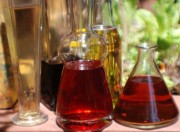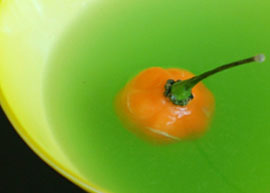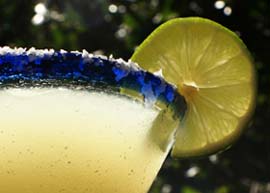Cherries—oh, how I love those sweet dark beauties this time of year. Eaten greedily out-of-hand or mixed into muffins and French clafoutis; better yet, flamed and spooned warm over a luscious bowl of Hagan Daz ice cream. Somehow the May-through-August season is just too short for me.
We’re especially lucky this year that the ongoing rains did not ruin the crop, but they did leave their mark. You’ll find the markets filled with cherries—big, fat perfectly round juicy ones and those known as “split” cherries, which are caused by the weather. These look like they grew, popped, split and then healed themselves. Splits taste as good as their perfect sisters but being “ugly” fetches a lower price. Split cherries are great in jam, and in cooked desserts, savory and barbecue sauces. They make good eating and are economical for those on a tight food budget.
Cherries are fairly expensive at three to five dollars a pound but will go on sale in a few weeks. The organic varieties are plentiful and run four to five dollars a pound. Be vigilant and don’t get robbed by markets and vendors charging far more. Also, roadside stands are not always the bargain they used to be. I found one selling split cherries for the same price local high-end markets were charging for premium ones. Distressing. Of course, the sweetest bargains come straight off your backyard tree or in a large, fruit-filled paper sack from a friend.
As you enjoy your cherries, know that they are one of the oldest cultivated fruits and a distant relative of peaches, plums and apricots.
Cherries originated in the southern region around the Black Sea, and their seeds were transported by birds to Europe where they flourished and became wildly popular in Rome 60 BC. The British brought them across the ocean to America in the late 1620s. Spanish missionaries planted the first cherries in California, where they have evolved into a major crop today.
Oregon grower Seth Luelling originally grafted my favorite sweet cherries in 1875 and named them “Bing” for his Manchurian foreman. Modern Bing trees are a direct descendent of those early efforts
How to Select Sweet Cherries
For best flavor and sweetness, select cherries that are plump yet firm to the touch. Sweet cherries are best when a shiny deep garnet red to almost black color with healthy green stems Avoid bruised, cut or mushy fruit and those with brown, dried-up stems. Fresh cherries keep well in the refrigerator for two to four days, but begin softening after that.
How to Store Sweet Cherries
Place your unwashed cherries with attached stems in a paper (not plastic) bag in the coldest section of your refrigerator. Cherries absorb water through their skins and spoil quickly after washing or when stored in moisture-trapping plastic.
Remove the cherries from the refrigerator when ready to use and bring to room temperature before washing.
How to Freeze Sweet Cherries
There are several ways to freeze cherries for use throughout the year. The easiest is to place them pitted in a zip-lock bag and remove all the air before sealing. Thaw the cherries in the refrigerator and bring them to room temperature before using.
If you want perfectly round cherries for presentation, place them individually on a baking sheet and set in the freezer until frozen. Scoop them all up and proceed as directed above.
Now pardon me, two five-year olds just challenged me to a pit-spitting contest. It’s time they learned from a pro.
Become a Beyond Wonderful Facebook fan.
Print my sweet cherry recipes for your convenience. All work well with both fresh and thawed, frozen fruit.
Cherries Jubilee—an impressive, elegant dessert that may seem complicated or fussy, but is in fact super simple. I made this at my very first dinner party when I was 20. The guests were so impressed when I lit it on fire in a silver chafing dish that they never suspected how nervous I was.
Cherry-Almond Clafouti—A warm, fragrant Sunday morning breakfast or brunch dish easily dressed up with a sprinkling of powdered sugar.
Cherry-Almond Muffins—these scrumptious buttermilk muffins use fresh or thawed frozen cherries and sport a crunchy almond-coconut topping. Sensational!

















